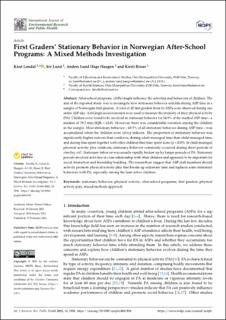| dc.contributor.author | Løndal, Knut | |
| dc.contributor.author | Lund, Siv | |
| dc.contributor.author | Haugen, Anders L. Hage | |
| dc.contributor.author | Riiser, Kirsti | |
| dc.date.accessioned | 2021-06-11T07:44:45Z | |
| dc.date.available | 2021-06-11T07:44:45Z | |
| dc.date.created | 2021-02-17T12:58:39Z | |
| dc.date.issued | 2021-02-17 | |
| dc.identifier.citation | International Journal of Environmental Research and Public Health (IJERPH). 2021, 18 (4), 1-14. | en_US |
| dc.identifier.issn | 1661-7827 | |
| dc.identifier.issn | 1660-4601 | |
| dc.identifier.uri | https://hdl.handle.net/11250/2758923 | |
| dc.description.abstract | After-school programs (ASPs) might influence the activities and behaviors of children. The aim of the reported study was to investigate how stationary behavior unfolds during ASP time in a sample of Norwegian first graders. A total of 42 first graders from 14 ASPs were observed during one entire ASP day. ActiGraph accelerometers were used to measure the intensity of their physical activity (PA). Children were found to be involved in stationary behavior for 54.9% of the studied ASP time—a median of 79.5 min (IQR = 62.0). However, there was considerable variation among the children in the sample. Most stationary behavior—63.5% of all stationary behavior during ASP time—was accumulated when the children were sitting indoors. The proportion of stationary behavior was significantly higher indoors than outdoors, during adult-managed time than child-managed time, and during time spent together with other children than time spent alone (p < 0.05). In child-managed physical activity play outdoors, stationary behavior commonly occurred during short periods of standing still. Stationary behavior was usually rapidly broken up by longer periods of PA. Stationary periods involved activities in close relationship with other children and appeared to be important for social interaction and friendship building. The researchers suggest that ASP staff members should actively promote physical activity play that breaks up sedentary time and replaces some stationary behaviors with PA, especially among the least active children. | en_US |
| dc.description.sponsorship | This research was funded by the Norwegian Fund for Postgraduate Training in Physiother apy and the Oslo Metropolitan University (OsloMet). Open access was funded by OsloMet. | en_US |
| dc.language.iso | eng | en_US |
| dc.publisher | MDPI | en_US |
| dc.relation.ispartofseries | International Journal of Environmental Research and Public Health;Volume 18 / Issue 4 | |
| dc.rights | Navngivelse 4.0 Internasjonal | * |
| dc.rights.uri | http://creativecommons.org/licenses/by/4.0/deed.no | * |
| dc.subject | Stationary behaviors | en_US |
| dc.subject | Physical activities | en_US |
| dc.subject | After-school programs | en_US |
| dc.subject | First graders | en_US |
| dc.subject | Physical activity play | en_US |
| dc.subject | Mixed methods approaches | en_US |
| dc.title | First graders’ stationary behavior in Norwegian after-school programs: A mixed methods investigation | en_US |
| dc.type | Peer reviewed | en_US |
| dc.type | Journal article | en_US |
| dc.description.version | publishedVersion | en_US |
| dc.rights.holder | © 2021 by the authors. | en_US |
| dc.source.articlenumber | 1938 | en_US |
| cristin.ispublished | true | |
| cristin.fulltext | original | |
| cristin.qualitycode | 1 | |
| dc.identifier.doi | https://doi.org/10.3390/ijerph18041938 | |
| dc.identifier.cristin | 1890865 | |
| dc.source.journal | International Journal of Environmental Research and Public Health (IJERPH) | en_US |
| dc.source.volume | 18 | en_US |
| dc.source.issue | 4 | en_US |
| dc.source.pagenumber | 1-14 | en_US |

